|
|
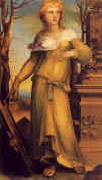 |
Domenico Beccafumi
|
|
c1486-1551
Domenico Beccafumi Gallery
Italian painter, sculptor, draughtsman, printmaker and illuminator. He was one of the protagonists, perhaps even the most precocious, of Tuscan Mannerism, which he practised with a strong sense of his Sienese artistic background but at the same time with an awareness of contemporary developments in Florence and Rome. He responded to the new demand for feeling and fantasy while retaining the formal language of the early 16th century. None of Beccafumis works is signed or dated, but his highly personal maniera has facilitated almost unanimous agreement regarding the definition of his corpus and the principal areas of influence on it. However, some questions concerning the circumstances of his early career and the choices available to him remain unanswered. The more extreme forms of Beccafumis reckless experimentation underwent a critical reappraisal only in the later 20th century. |
|
|
|
 |
domenico chirlandaio
|
|
Domenico Ghirlandaio (1449 - 11 January 1494) was an Italian Renaissance painter from Florence. Among his many apprentices was Michelangelo.
Ghirlandaio's full name is given as Domenico di Tommaso di Currado di Doffo Bigordi. The occupation of his father Tommaso Bigordi and his uncle Antonio in 1451 was given as 'setaiuolo a minuto,' that is, dealers of silks and related objects in small quantities. He was the eldest of six children born to Tommaso Bigordi by his first wife Mona Antonia; of these, only Domenico and his brothers and collaborators Davide and Benedetto survived childhood. Tommaso had two more children by his second wife, also named Antonia, whom he married in 1464. Domenico's half-sister Alessandra (b. 1475) married the painter Bastiano Mainardi in 1494.
Domenico was at first apprenticed to a jeweller or a goldsmith, most likely his own father. The nickname Il Ghirlandaio (garland-maker) came to Domenico from his father, a goldsmith who was famed for creating the metallic garland-like necklaces worn by Florentine women. In his father's shop, Domenico is said to have made portraits of the passers-by, and he was eventually apprenticed to Alessio Baldovinetti to study painting and mosaic. |
|
|
|
 |
DOMENICO DI BARTOLO
|
|
Italian Early Renaissance Painter, 1400-ca.1447
was an Italian painter of the Sienese School. He was born in Asciano. According to Vasari, he was a nephew of Taddeo di Bartolo. He was employed by Vecchietta in the masterpiece fresco The Care of the Sick in the Pellegrinaio (Pilgrim's Hall) of the Ospedale di Santa Maria della Scala in Siena[1]. It portrays wealthy donors visiting the hospital to men washing the ill, and a fatty friar hearing confession. In 1434, |
|
 |
DOMENICO DI MICHELINO
|
|
Italian painter, Florentine school (b. 1417, Firenze, d. 1491, Firenze)
Italian painter. He took his name from his teacher, a carver in bone and ivory named Michelino. He was elected to the Compagnia di S Luca in 1442 and joined the Arte dei Medici e degli Speziali on 26 October 1444. In 1459 he received payment from Lorenzo Pucci for a processional banner (untraced) for a confraternity based in S Francesco, Cortona. Four years later he was paid for some figures of saints (untraced) for a cupboard belonging to the Compagnia di S Maria della Purificazione e di S Zanobi,
|
|
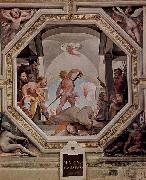 |
Domenico di Pace Beccafumi
|
|
(1486?CMay 18, 1551) was an Italian Renaissance-Mannerist painter active predominantly in Siena. He is considered one of the last undiluted representatives of the Sienese school of painting.
Domenico was born in Montaperti, near Siena, the son of Giacomo di Pace, a peasant who worked on the estate of Lorenzo Beccafumi. Seeing his talent for drawing, Lorenzo adopted him, and commended him to learn painting from Mechero, a lesser Sienese artist. In 1509 he traveled to Rome, but soon returned to Siena, and while the Roman forays of two Sienese artists of roughly his generation (Il Sodoma and Peruzzi) had imbued them with elements of the Umbrian-Florentine Classical style, Beccafumi's style remains, in striking ways, provincial. In Siena, he painted religious pieces for churches and of mythological decorations for private patrons, only mildly influenced by the gestured Mannerist trends dominating the neighboring Florentine school. |
|
 |
Domenico Fetti
|
|
Italian painter ,
Rome 1589 - Venice 1623
was an Italian Baroque painter active mainly in Rome, Mantua and Venice. Born in Rome to a little-known painter, Pietro Fetti, Domenico is said to have apprenticed initially under Ludovico Cigoli, or his pupil Andrea Commodi in Rome from circa 1604-1613. He then worked in Mantua from 1613 to 1622, patronized by the Cardinal, later Duke Ferdinando I Gonzaga. In the Ducal Palace, he painted the Miracle of the Loaves and Fishes. The series of representations of New Testament parables he carried out for his patron's studiolo gave rise to a popular specialty, and he and his studio often repeated his compositions. In August or September 1622, his feuds with some prominent Mantuans led him to move to Venice, which for the first few decades of the seventeenth century had persisted in sponsoring Mannerist styles (epitomized by Palma the Younger and the successors of Tintoretto and Veronese). Into this mix, in the 1620s?C30s, three "foreigners"??Fetti and his younger contemporaries Bernardo Strozzi and Jan Lys??breathed the first influences of Roman Baroque style. They adapted some of the rich coloration of Venice but adapted it to Caravaggio-influenced realism and monumentality. In Venice where he remained despite pleas from the Duke to return to Mantua, Fetti changed his style: his formalised painting style became more painterly and colourful. |
|
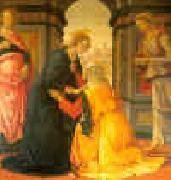 |
Domenico Ghirlandaio
|
|
Italian
1449-1494
Domenico Ghirlandaio Galleries
Painter, mosaicist and possibly goldsmith. He was head of one of the most active workshops in late 15th-century Florence. He developed a style of religious narrative that blended the contemporary with the historical in a way that updated the basic tenets of early Renaissance art. Domenico documented material situation |
|
 |
Domenico Induno
|
|
(1815 - 1878) was an Italian painter, originally a goldsmith.
He was born and died in Milan, and studied in the Academy of Fine Arts in Milan, as well as under Luigi Sabatelli and at Rome. He tried successively the Neoclassicism and Romantic schools, but afterwards settled down to depict popular life at Milan. In 1848 he took part with the Revolution, and had in consequence to flee to Switzerland. Thence he passed to Tuscany, and did not return home until 1859. His brother Gerolamo Induno was also a painter. Domenico married the sister of the Swiss painter Angelo Trezzini. Domenico often painted patriotic canvases, in a style indebted both to Ingres and Francesco Hayez. Among his paintings are:
|
|
|
|
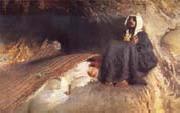 |
Domenico Morelli
|
|
Italian, 1826-1901,Italian painter and teacher. Unique among his Italian colleagues in enjoying an international reputation in his lifetime, he was, with Filippo Palizzi (see PALIZZI, (2)), the leading exponent of the Neapolitan school of painting in the second half of the 19th century and a major figure in the artistic and cultural life of Italy. His realistic treatment of Romantic subjects revitalized academic painting, |
|
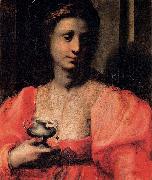 |
Domenico Puligo
|
|
(1492-1527) was an Italian painter of the Renaissance, active in Florence. His real name was Domenico di Bartolommeo Ubaldini.
He was trained by Ridolfo Ghirlandaio, but acquired a style consistent with his contemporary Andrea del Sarto. He painted a Vision of Saint Bernard altarpiece, now in Walters' Gallery in Baltimore. He was also in demand for portraits. He is featured in Giorgio Vasari's Vite or biographies of artists. He excelled as a portrait painter. He befriended Andrea del Sarto ane worked with Ridolfo Ghirlandaio. His brother, Jacone Puligo was also a Renaissance painter.
|
|
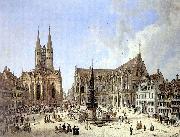 |
Domenico Quaglio
|
|
(1787-1837) was a German painter, engraver, stage designer, and architect. He was the second son of Giuseppe Quaglio and part of the large Quaglio pedigree of Italian artists involved in architecture, indoor fresco decoration, and scenography for the court theaters. He known as a landscape and architectural painter/decorator, including quadratura. He was born in Munich. He was taught perspective and scene-painting by his father, and engraving by Mettenleiter and Karl Hess. In 1819 he resigned his post as scene-painter, and occupied himself only with architecture, for which he obtained subjects in the Netherlands, Italy, France, and England. As architect in charge, Domenico Quaglio was responsible for the neogothic style of the exterior design of Hohenschwangau Castle, summer and hunting residence of King Maximilian II of Bavaria, son of King Ludwig I of Bavaria and father of King Ludwig II. Quaglio died at Hohenschwangau in 1837. |
|
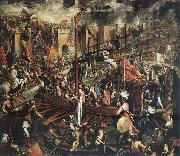 |
Domenico Tintoretto
|
|
Italian, 1560-1635,Son of Jacopo Tintoretto. He was taught by his father and assisted him in his workshop. At the age of 17 he was admitted to the Venetian painters' guild, and he is recorded in the confraternity of painters from 1594. He began his career by helping his father to execute the paintings in the Sala del Collegio and Sala del Senato in the Doge's Palace, Venice. Following this he worked independently at the palace, on the Sala dello Scrutinio and the Sala del Maggiore Consiglio. His training with his father helped him in his own compositions, several of which, such as the Battle of Salvore, or the Second Conquest of Constantinople, are heroic battle themes with complex groupings and dramatic poses. In the last two decades of the 16th century Domenico concentrated on religious commissions in Venice, including a Last Supper and Crucifixion (both c. 1583) for S Andrea della Zirada (both in situ), a Marriage of the Virgin for S Giorgio Maggiore (in situ) and a Crucifixion for the Scuola dei Mercanti. |
|
|
|
 |
Domenico Zampieri
|
|
(October 21, 1581 C April 16, 1641) was an Italian Baroque painter of the Bolognese School, or Carracci School, of painters.
Domenichino was born at Bologna, son of a shoemaker, and there initially studied under Denis Calvaert. After quarreling with Calvaert, he left to work in the Accademia degli Incamminati of the Carracci where, because of his small stature, he was nicknamed Domenichino, meaning "little Domenico" in Italian. He left Bologna for Rome in 1602 and became one of the most talented apprentices to emerge from Annibale Carracci's supervision. As a young artist in Rome he lived with his slightly older Bolognese colleagues Albani and Guido Reni, and worked alongside Lanfranco, who later would become a chief rival.
In addition to assisting Annibale with completion of his frescoes in the Galleria Farnese, including A Virgin with a Unicorn (c. 1604-5), he painted three of his own frescoes in the Loggia del Giardino of the Palazzo Farnese c. 1603-04. With the support of Monsignor Giovanni Battista Agucchi, the maggiordomo to Cardinal Aldobrandini and later Gregory XV, and Giovanni??s brother Cardinal Girolamo Agucchi, Domenichino obtained further commissions in Rome. His most important project of the first decade was decoration of the Cappella dei Santissimi Fondatori in the medieval basilica of the Abbey of Grottaferrata (1608-10), some 20 kilometers outside Rome, where Odoardo Farnese was the titular abbot. Meanwhile he had completed frescoes c. 1604-05 in the church of Sant'Onofrio, feigned stucco decoration of 1606-07 in the Palazzo Mattei, a large scene of The Flagellation of St. Andrew at San Gregorio Magno, painted in competition with a fresco by Reni that faces it, and a ceiling with Scenes from the Life of Diana, 1609, in the Villa Odescalchi at Bassano di Sutri (today Bassano Romano).
Following Annibale Carracci's death in 1609, Annibale's Bolognese pupils, foremost Domenichino, Albani, Reni and Lanfranco, became the leading painters in Rome (Caravaggio had left Rome in 1606 and his followers there did not compete successfully with the Bolognese for fresco or altarpiece commissions). One of Domenichino's masterpieces, his frescoes of Scenes of the Life of Saint Cecilia in the Polet Chapel of San Luigi dei Francesi, was commissioned in 1612 and completed in 1615. Concurrently he painted his first, and most celebrated, altarpiece, The Last Communion of St. Jerome for the church of San Girolamo della Carite (signed and dated, 1614). It subsequently would be judged as being comparable to Raphael great Transfiguration and even as "the best picture in the world."
By late 1616, Domenichino had designed the coffered ceiling with The Assumption of the Virgin in Santa Maria in Trastevere; and he had begun a cycle of ten frescoes depicting the Life of Apollo in a garden pavilion of the Villa Aldobrandini (Belvedere) in Frascati, where he was assisted by Giovanni Battista Viola, a Bolognese artist who, like Domenichino himself, was a pioneer in the development of classicistic landscape painting. From 1617 until 1621, Domenichino was absent from Rome, working in Bologna and at Fano, where during 1618-19 he frescoed the Nolfi chapel of the Fano Cathedral with Scenes from the Life of the Virgin.
With the election of a Bolognese pope (Gregory XV) in 1621, Domenichino returned to Rome. Appointed Papal Architect (he built little but left drawings for various projects, most notably for the façade of Sant'Andrea della Valle and for the plan of Sant'Ignazio, both in Rome), he nonetheless continued to be most active as a painter, obtaining many commissions for altarpieces in Roman churches (San Lorenzo in Miranda, 1626-27, SS. Giovanni Evangelista e Petronio dei Bolognese, 1626-29, Santa Maria della Vittoria, 1629-30, and St. Peter's, 1625-30). He also executed numerous frescoes in Rome during the 1620s: a ceiling in the Palazzo Costaguti (c. 1622); the choir and pendentives in Sant'Andrea della Valle, where he worked in fierce competition with Lanfranco, who painted the dome above Domenichino's pendentives; and the pendentives of San Silvestro al Quirinale (c. 1628) and San Carlo ai Catinari (1628-30). |
|
|
|
|
|
|
|
|
|
|
|
 |
Dominique Vivant Denon
|
|
French, 1747-1825,French savant, he accompanied the Napoleonic expedition to Egypt (1798) as leader of the learned Commission on the Sciences and Arts that was to study Ancient Egyptian buildings and architecture and herald the birth of modern Egyptology. In 1802 he published his Voyage dans la Basse et la Haute Egypte pendant les campagnes du general Bonaparte (Journey in Lower and Upper Egypt during the campaigns of General Bonaparte). An accurate source-book of Ancient Egyptian architecture, it had an extraordinary impact, triggering the C19 Egyptian Revival that at first was correctly described as Egyptomania, and was a major influence on Neo-Classicism. Denon was Director-General of Museums, and was in charge of the Musee Napoleon (now the Louvre). |
|
|
|
 |
Donatello
|
|
Italian Early Renaissance Sculptor, 1386-1466,Italian sculptor. He was the most imaginative and versatile Florentine sculptor of the early Renaissance, famous for his rendering of human character and for his dramatic narratives. He achieved these ends by studying ancient Roman sculpture and amalgamating its ideas with an acute and sympathetic observation of everyday life. Together with Alberti, Brunelleschi, Masaccio and Uccello, Donatello created the Italian Renaissance style, which he introduced to Rome, Siena and Padua at various stages of his career. He was long-lived and prolific: between 1401 and 1461 there are 400 documentary references to him, some for nearly every year. |
|
|
|
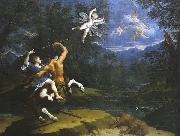 |
Donato Creti
|
|
(1671-1749) was an Italian painter of the Rococo period, active mostly in Bologna.
Born in Cremona, he moved to Bologna, where he was a pupil of Lorenzo Pasinelli. He is described by Wittkower as the "Bolognese Marco Benefial", in that his style was less decorative and edged into a more formal neoclassical style. It is an academicized grand style, that crystallizes into a manneristic neoclassicism, with crisp and frigid modeling of the figures. Among his followers were Aureliano Milani, Francesco Monti, and Ercole Graziani the Younger. Two other pupils were Domenico Maria Fratta and Giuseppe Peroni |
|
|
|
 |
Dora Carrington
|
|
British Painter,
1893-1932
English painter and decorative artist. Daughter of a Liverpool merchant, she was brought up in Bedford. She trained at the Slade School of Fine Art in London where she met John Nash, who aroused her interest in wood-engraving, and Mark Gertler, whose powerful figure paintings influenced her own approach to portraiture. She rejected Gertler as a lover and set up home with the homosexual essayist and biographer Lytton Strachey (1880-1932), first at Tidmarsh Mill, near Pangbourne, Berks, then at Ham Spray, between Newbury and Hungerford, Berks. In 1921 she married Ralph Partridge, living with him and Strachey in a m?nage ? trois, surrounded mainly by literary friends and receiving little encouragement to exhibit. She turned instead to decorative work, emulating Vanessa Bell and Duncan Grant but in a style more native in inspiration and more naive. She designed tiles and inn signs, experimented with painting on glass and tinfoil, decorated furniture and designed the library at Ham Spray. |
|
|
|
|
|
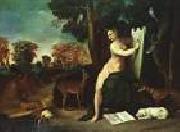 |
DOSSI, Dosso
|
|
Italian High Renaissance Painter, ca.1490-1542
Although responsive to a wide range of outside influences, the most important of which were probably those of Giorgione in Venice and Raphael in Rome, he was an artist of great originality with a strong feeling for effects of light and colour. Landscape plays a prominent and highly expressive role in his work. He was employed, as were also the poets Matteomaria Boiardo (?1441-94) and Ludovico Ariosto, at the court of Ferrara, which was internationally renowned for its culture, especially its musical life and collections of art: one of his best-known works is an illustration of a magical scene from Ariosto's poetry, |
|
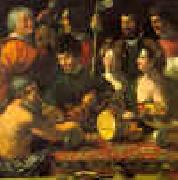 |
Dosso Dossi
|
|
1479-1542
Italian
Dosso Dossi Locations
Italian painter of the Ferrarese school, whose real name was Giovanni di Niccolo de Luteri. He may have been a pupil of Lorenzo Costa, but was certainly influenced by Giorgione, Titian, and Raphael. He often collaborated with his brother Battista, a landscape painter. Dosso Dossi is first recorded in Mantua, but after 1514 he executed many decorative works for the ducal palace and churches of Ferrara, including frescoes, pictures, and cartoons for tapestries. Both his landscapes and portraits show originality and imagination. He was a friend of Ariosto, who mentions him in Orlando Furioso. His works include Circe in the Woods (Borghese Villa); The Three Ages of Man (Metropolitan Mus.); The Standard Bearer, Scene from a Legend, and Saint Lucretia (National Gall. of Art, Washington, D.C.). |
|
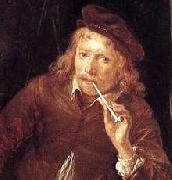 |
DOU, Gerrit
|
|
Dutch Baroque Era Painter, 1613-1675
Dutch painter. The first and most famous member of the group of artists referred to as the LEIDEN 'FINE' PAINTERS, he specialized in small-format paintings, the details and surfaces of which are carefully observed and meticulously rendered. He was greatly praised as a painter of artificial light by Samuel van Hoogstraten in 1678, and he was responsible for popularizing both the night scene and the 'niche' format, pictorial devices ultimately derived from the art of his famous master, Rembrandt.
|
|
|
|
|
|
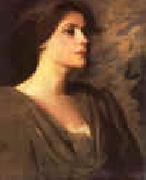 |
Douglas Volk
|
|
1856-1935
Douglas Volk (1856 - 1935) was an American portrait painter and the son of noted sculptor Leonard Volk. He was named after his mother's cousin (Abraham Lincoln's political rival) Stephen A. Douglas. |
|
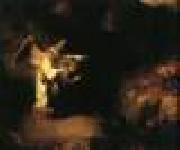 |
DROST, Willem
|
|
Dutch Baroque Era Painter, ca.1630-1680
Dutch painter, draughtsman and printmaker, possibly of German origin. According to Houbraken, he was a pupil of Rembrandt, possibly in or shortly before 1650. An early etching signed w drost 1652 is probably a self-portrait, in which Drost portrayed himself as a young man drawing. His earliest dated paintings are two pendants of 1653: the Portrait of a Man (New York, Met.) and the Portrait of a Woman (The Hague, Mus. Bredius). The man's portrait is signed Wilhelmus Drost F. Amsterdam 1653 |
|
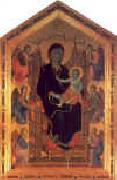 |
Duccio
|
|
1255-c1319
Italian
Duccio Location
Italian painter. He was one of the most important painters of the 14th century and like his slightly younger contemporary, Giotto, was a major influence on the course of Italian painting. An innovator, he introduced into Sienese painting new altarpiece designs, a dramatic use of landscape, expressive emotional relationships, extremely complex spatial structures and a subtle interplay of colour. His most important and revolutionary work, the Maeste for Siena Cathedral, was never matched during the 14th century, if at all, and his influence lasted well into the 15th century. |
|
 |
Duccio di Buoninsegna
|
|
1255-1318
Italian Duccio di Buoninsegna Locations
Italian painter. He was one of the most important painters of the 14th century and like his slightly younger contemporary, Giotto, was a major influence on the course of Italian painting. An innovator, he introduced into Sienese painting new altarpiece designs, a dramatic use of landscape, expressive emotional relationships, extremely complex spatial structures and a subtle interplay of colour. His most important and revolutionary work, the Maeste for Siena Cathedral, was never matched during the 14th century, if at all, and his influence lasted well into the 15th century. |
|
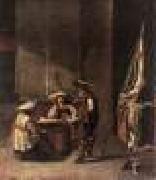 |
DUCK, Jacob
|
|
Dutch painter (b. ca. 1600, Utrecht, d. after 1660, Utrecht) |
|
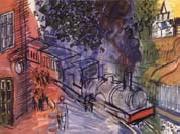 |
Dufy Raoul
|
|
Le Havre 1877-Forcalquier 1953
was a French Fauvist painter. He developed a colourful, decorative style that became fashionable for designs for ceramics, textiles and decorative schemes for public buildings. He is noted for scenes of open-air social events. Raoul Dufy was born at Le Havre, in Normandy, one of a family of nine members. He left school at the age of 14 to work in a coffee importing company. In 1895 when he was 18, he started evening classes in art at Le Havre Ecole des Beaux-Arts. He and Othon Friesz, a school friend, studied the works of Eug??ne Boudin in the museum in Le Havre. Raoul Dufy, Regatta at Cowes, (1934), Washington D.C. National Gallery of Art.In 1900, after a year of military service, Raoul won a scholarship enabling him to attend the Ecole Nationale des Beaux-Arts in Paris, where he was a fellow student with Georges Braque. The impressionist landscapists, such as Claude Monet and Camille Pissarro, influenced him. Introduced to Berthe Weill in 1902, she showed his work in her gallery. Henri Matisse's Luxe, Calme et Volupte, which Dufy saw at the Salon des Independants in 1905, was a revelation to the young artist and directed his interest towards Fauvism. Les Fauves (wild beasts) emphasised bright colour and rich bold contours in their work, and Dufy's painting reflects this approach until about 1909, when contact with the work of Paul Cezanne led him to adopt a somewhat subtler technique. |
|
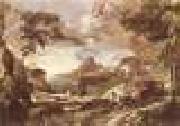 |
DUGHET, Gaspard
|
|
French Baroque Era Painter, 1615-1675
Italian painter. He was one of the most distinguished landscape painters working in Rome in the 17th century, painting decorative frescoes and many easel paintings for such major Roman patrons as Pope Innocent X and the Colonna family. He is associated with a new genre of landscape, the storm scene, although of some 400 catalogued works little more than 30 treat this theme. His most characteristic works depict the beauty of the scenery around Rome, particularly near Tivoli, and suggest the shifting patterns of light and shade across a rugged terrain. Dughet drew from nature, yet his landscapes are carefully structured, and figures in antique dress suggest the ancient beauty of a landscape celebrated by Virgil. Very few can be securely dated; his development may be inferred from his few dated fresco paintings and from the wider context in which he was working. Most writers, following Pascoli, have divided Dughet's career into three periods. |
|
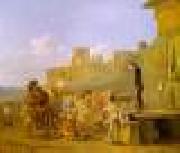 |
DUJARDIN, Karel
|
|
Dutch Baroque Era Painter, ca.1622-1678
Dutch painter and etcher. He studied with Berchem and in Italy. Dujardin was particularly successful in painting landscapes with figures and animals, and he made some 51 fine etchings of similar subjects. |
|
|
|
|
|
|
|
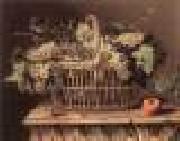 |
DUPUYS, Pierre
|
|
French painter (b. 1610, Montfort l'Amaury, d. 1682, Paris).
|
|
 |
Durrie George Henry
|
|
American Painter
b.1820 d.1863
Durrie and his older brother John (1818-98) studied sporadically from 1839 to 1841 with the portrait painter Nathaniel Jocelyn. From 1840 to 1842 he was an itinerant painter in Connecticut and New Jersey, finally settling permanently in New Haven. He produced c. 300 paintings, of which the earliest were portraits (e.g. Self-portrait, 1839; Shelburne, VT, Mus.); by the early 1850s he had begun to paint the rural genre scenes and winter landscapes of New England that are considered his finest achievement. His landscapes, for example A Christmas Party (1852; Tulsa, OK, Gilcrease Inst. Amer. Hist. & A.), are characterized by the use of pale though cheerful colours and by the repeated use of certain motifs: an isolated farmhouse, a road placed diagonally leading the eye into the composition, and a hill (usually the West or East Rocks, New Haven) in the distance. By the late 1850s Durrie's reputation had started to grow, and he was exhibiting at prestigious institutions, such as the National Academy of Design. In 1861 the firm of Currier & Ives helped popularize his work by publishing prints of two of his winter landscapes, New England Winter Scene (1858; Mr and Mrs Peter Frelinghuysen Carleton priv. col.) and the Farmyard in Winter. |
|
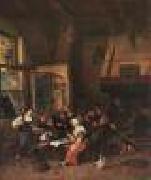 |
DUSART, Cornelis
|
|
Dutch Baroque Era Painter, 1660-1704
Dutch painter, draughtsman and printmaker. He was the son of the organist at St Bavo in Haarlem and one of the last pupils of Adriaen van Ostade. He became a member of the Haarlem Guild of St Luke on 10 January 1679 and served as its dean in 1692. Dated pictures by Dusart have survived from almost every year between 1679 and 1702. Two of his earliest pictures of peasants relied heavily on compositions by van Ostade: Mother and Child (1679; Dresden, Gemeldegal. Alte Meister) and Woman Selling Milk (1679; sold Amsterdam, Muller, 16 Oct 1928, lot 9; the original drawing by van Ostade is in Paris |
|
|

